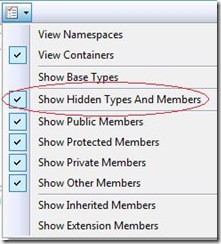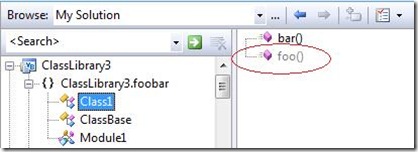Did you know… You can hide or show hidden members and types in the Object Browser? - #215
I never officially tested the object browser, but rather played back-up tester, in case someone went on vacation, needed help analyzing failures during a full test pass, etc. So for most of these tips, i’ve been browsing their test cases and documentation to make sure i’m describing things consistently and to make sure i’m not missing any functionality.
I have to put the documentation for today’s tip in the hot seat. But first, today’s tip is about the Show Hidden Types and Members option on the Object Browser Settings.
When enabled, any hidden types and members will appear, but in a grayed-out state, as shown below in the classic foo() and bar() example, where foo() is hidden.
Now, time to talk about the documentation. When I read,
Show Hidden Types and Members: Toggles display of hidden types in the Objects pane and hidden members in the Members pane.
I thought, “where’s the example?” because the obvious next question is “how do create a hidden type or hidden member that Visual Studio knows how to pick up on?”
The answer is tomorrow’s tip, which many of you know, but I gotta meet my tip of the day quota somehow. =)
Seriously though, I would love it if each documentation option like this came with an actual example of how to use. Not just a “here’s it working” but a “here are all the steps needed to use the feature?” You could even go one step further and say, “and here are the ideal situations for using this feature.” Maybe Tip of the Day can be a conduit for change, if I have any energy left at the end. =p

